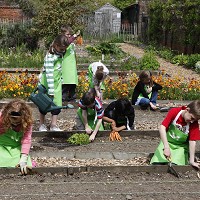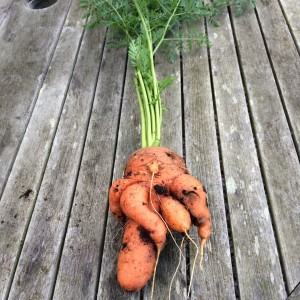What to do in your organic veg patch in May

Do you grow organically, or want to try? Here is a great resource to help you grow great fruit and veg at home from our friends at Garden Organic. Like BigBarn Garden Organic work with schools to get kids growing veg and they are supporting our petition to get Food Growing on the national curriculum (please sign here).
So here is what they are suggesting to do in May:
May is a busy month in the garden. Winter is well passed and the world feels full of energy – including the gardener!
Don’t forget the two organic principles: good soil management, and diverse planting to encourage plenty of beneficial wildlife. And keep on top of the weeds.
See below for advice on soil, vegetables, fruit, herbs and flowers as well as the greenhouse and conservatory.

learning through doing
Keep your soil in good heart at all times and see the difference. Garden compost or well-rotted manure helps soil structure. It improves drainage in heavy clay soils, and retains moisture and nutrients in free-draining sandy or stony soils. Now is a good time to apply it. The organic material breaks down slowly over months, releasing nourishment for the plants.
Grow fast-growing green manure plants, such as Crimson clover Trifolium incarnatum, where there are areas of bare soil – for instance where summer or autumn vegetables are yet to be planted out. If you dig it in before July, it will not only keep down weeds but also fix precious nitrogen in the soil.
Keep adding to your compost bin, making sure to mix ‘greens’ (lawn cuttings etc), with ‘browns’ (cardboard, straw and scrumpled up paper).

Green Manure & pollinator
Use last year’s compost to mulch on top of the soil around plants; always add mulch after rain to help keep moisture in.
Hoe regularly to keep down weeds. Chickweed will produce 2000 seeds per plant per season if left untouched.
Fill any empty gaps awaiting vegetables with a fast-growing cover crop of green manures. Buckwheat, mustard, phacelia or trefoil can all be sown in May if the ground is moist enough. See Green Manures
Pest and Disease Watch
Slug control – use all available methods to protect your new young plants. See Slugs in Pests and Diseases It is often worth starting new plants in pots or modules, and planting out only vigorous transplants.

Ugly but nutritious non GM carrot
Brassica-collar Also erect a mesh barrier to cover plants completely to keep cabbage white butterflies from laying their eggs on leaves. Squash or pick off any you see. Flea beetles are also pests of brassicas (the cabbage family), and radish, rocket, mustard and other related plants. They are particularly damaging to young seedlings, especially during dry weather. See Pests and Diseases
Fruit
Keep fleece handy to protect blossoms from late frost. Including strawberry plants. Remove during the day to let pollinating insects in.

Real fresh ripe jamming strawberries
Keep at least 1 square metre of ground weed-free around all fruit trees and bushes – particularly young ones. This prevents grass and weeds competing for nutrients. However, established fruit trees on vigorous rootstocks will not be affected by grass growing right up to the trunk,
Water all recently planted fruit trees – thoroughly once or twice a week rather than little and often; varieties on dwarfing rootstocks and wall-trained fruit may continue to need watering in dry weather for several years.
Use a mulch (straw, grass cuttings etc) on moist soil round trees and soft fruit to retain moisture and deter weeds. FS Mulches: weed prevention and control
Net strawberries to deter birds, once fruits start swelling and ripening. Ensure netting is pegged down to prevent birds getting trapped or tangled up.
Pest and disease watch

Fresh, bird food?
Put up codling moth traps in fruit trees.
Pick off and destroy emerging larvae of apple and plum sawfly at petal fall. You need to catch them before they start tunneling into fruit. Look for creamy white larvae, about 15mm long, around the fruiting spurs.
Gooseberry sawfly larvae Inspect gooseberry bushes twice-weekly for gooseberry sawfly larvae (pictured). Eggs are laid under leaves in the centre of the bush, and pinprick sized holes are the very first signs of larval damage. Pick off and destroy the tiny larvae

Chives and herbs patch
Allow herbs to flower, for pollinating bees.
Top dress herbs growing in containers. Scrape off the top 4cm/2” of compost, and replace with a 50/50 mixture of fresh potting compost (peat-free and organic) and garden compost.
Greenhouse and conservatory
Remove and dispose of any dying foliage on sight. Disease prevention in a greenhouse relies on good hygiene.
Temperatures should be high enough by now to use all types of biological controls for red spider mite, aphids and white fly, and require 18-20°C for a couple of hours a day.
This is direct from Garden Organic’s website and has some great tips every month. We will continue to quote and expand on their input next month. For more on grow your own and building communities around food please read our Next Big Idea blog here. As the Brexit squabbles continue we all need to get growing food?

Your Local Food Map?
You will find places on our Local Food Map that have opted in with a carrot flag on their icon. You could even approach your local shop, pub or restaurant and supply them with fresh produce in return for a pint of beer or meal.
And please advise them to join our map if they do opt in.